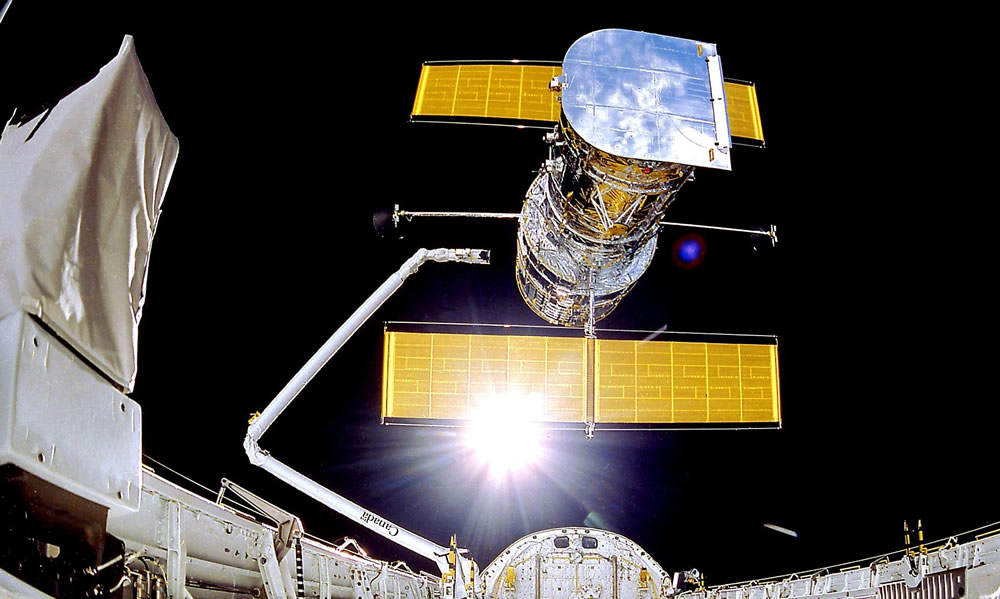Noticias y novedades sobre astronomía escritas por el periodista especializado Hernán Julio

This illustration depicts a collapsing star that is producing two short gamma-ray jets. Just before a massive, collapsing star explodes as a supernova, we often observe a gamma-ray burst (a brief explosion of gamma-ray radiation) if the jets are pointed toward Earth. Most known supernova-produced gamma-ray bursts are “long” (lasting more than two seconds), but one called GRB 200826 was “short” (lasting just 0.6 second). Astronomers think this, and possibly other short supernova-produced gamma-ray bursts, appeared short because the jets of gamma rays aren’t strong enough to completely escape the star. This would produce jets that are shorter in both length and duration.
Un equipo internacional de más de 50 investigadores liderados por el astrónomo chileno Matías Ahumada, descubrió la emisión de rayos gamma más breve causada por la explosión de una estrella…
El Telescopio Espacial James Webb de la NASA, que será el principal observatorio de la próxima década, sigue en el período programado para una fecha de preparación para el lanzamiento…
El Brazo Robótico Europeo (ERA) se encuentra de camino a la Estación Espacial Internacional después de su lanzamiento a bordo de un cohete Protón desde el cosmódromo de Baikonur, en…

This image, taken with the Atacama Large Millimeter/submillimeter Array (ALMA), in which ESO is a partner, shows the PDS 70 system, located nearly 400 light-years away and still in the process of being formed. The system features a star at its centre and at least two planets orbiting it, PDS 70b (not visible in the image) and PDS 70c, surrounded by a circumplanetary disc (the dot to the right of the star). The planets have carved a cavity in the circumstellar disc (the ring-like structure that dominates the image) as they gobbled up material from the disc itself, growing in size. It was during this process that PDS 70c acquired its own circumplanetary disc, which contributes to the growth of the planet and where moons can form.
Utilizando el Atacama Large Millimetre/submillimeter Array (ALMA), del que el Observatorio Europeo Austral (ESO) es socio, la comunidad astronómica ha detectado inequívocamente, y por primera vez, la presencia de un…
El pasado 7 de Junio, la nave espacial Juno de NASA pasó más cerca de Ganímedes, la luna helada de Júpiter, que ninguna otra nave espacial en las últimas dos…

This image of the nearby galaxy NGC 4303 was obtained by combining observations taken with the Multi-Unit Spectroscopic Explorer (MUSE) on ESO’s Very Large Telescope (VLT) and with the Atacama Large Millimeter/submillimeter Array (ALMA), in which ESO is a partner. NGC 4303 is a spiral galaxy, with a bar of stars and gas at its centre, located approximately 55 million light-years from Earth in the constellation Virgo. The image is a combination of observations conducted at different wavelengths of light to map stellar populations and gas. ALMA’s observations are represented in brownish-orange tones and highlight the clouds of cold molecular gas that provide the raw material from which stars form. The MUSE data show up mainly in gold and blue. The bright golden glows map warm clouds of mainly ionised hydrogen, oxygen and sulphur gas, marking the presence of newly born stars, while the bluish regions reveal the distribution of slightly older stars. The image was taken as part of the Physics at High Angular resolution in Nearby GalaxieS (PHANGS) project, which is making high-resolution observations of nearby galaxies with telescopes operating across the electromagnetic spectrum.
Un equipo de astrónomos ha publicado nuevas observaciones de galaxias cercanas que se asemejan a coloridos fuegos artificiales cósmicos. Las imágenes, obtenidas con el Very Large Telescope del Observatorio Europeo…
El Telescopio Espacial Hubble de la NASA vuelve a estar en funcionamiento, explorando el universo y regresando a sus operaciones científicas. Los instrumentos científicos han vuelto a funcionar a pleno…
"Comandante Moonikin Campos" es el nombre oficial del maniquí que se lanzará a bordo de Artemisa I, el vuelo de prueba sin tripulación de la NASA del cohete SLS y la nave espacial…
Un nuevo artículo de investigación enriquece la comprensión de los científicos sobre los lugares dónde el registro de rocas conservó o destruyó indicios del pasado de Marte y posibles signos…
Gracias a los datos del satélite TESS de la NASA, una colaboración internacional de astrónomos ha identificado cuatro exoplanetas, mundos más allá de nuestro sistema solar, que orbitan un par…










